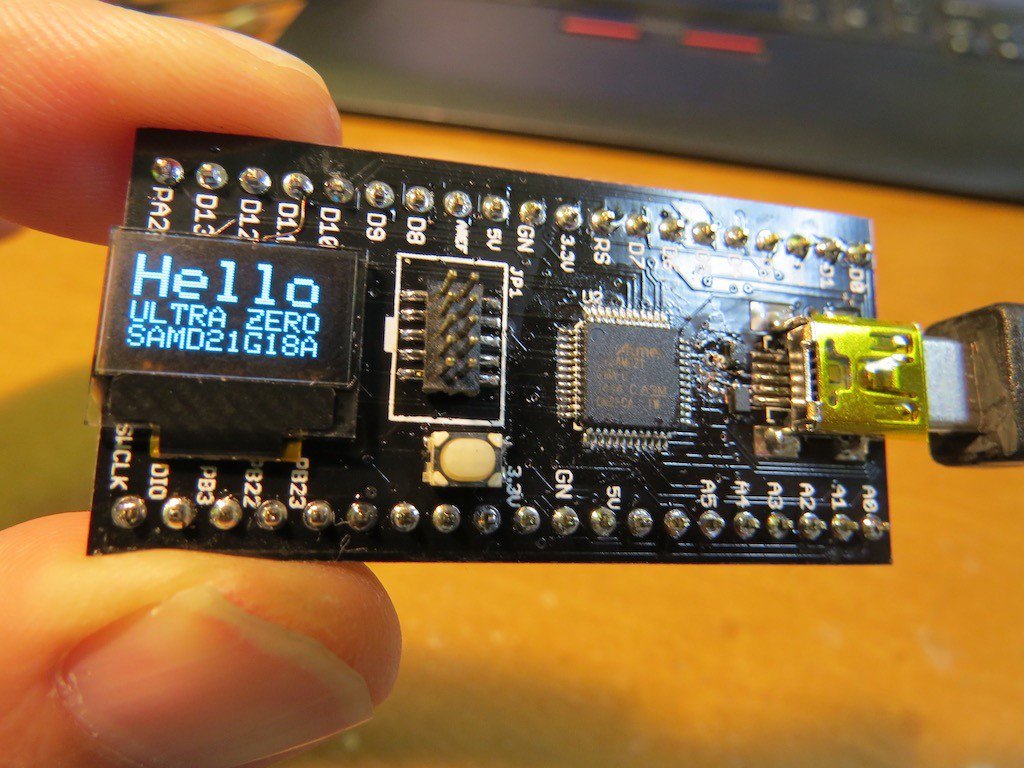8Bit or 32Bit processors
-
It won't incorporate USB anyways, so I do not see a benefit of using D21.. And even 0.5$ could become a lot of money, when we start producing a million sensebender micro mk2 :)
@tbowmo said in 8Bit or 32Bit processors:
It won't incorporate USB anyways, so I do not see a benefit of using D21.. And even 0.5$ could become a lot of money, when we start producing a million sensebender micro mk2 :)
Yes yes I'm not talking about the sensebender micro for which saving money for a feature you don't use makes sense. But for small scale production like in my appartment ? :D
-
@Nca78
depends what you need, but what i like with usb (d21) is i just connect the cable and i can program it easily and at same time can have serial monitor (no ftdi needed). You need to burn a bootloader for that by using a swd programmer first.
or then use the cheaper version, program it through swd, but then need an ftdi for uart
depends.
perhaps i should release some design for it, but i think there are already a lot on internet -
@NeverDie i'm using atsamd21 with mysensors since last year, no problem too with VS Studio ;)
@scalz said in 8Bit or 32Bit processors:
@NeverDie i'm using atsamd21 with mysensors since last year, no problem too with VS Studio ;)
And do you have to put a bootloader on it ? If yes what do you use for programming ?
-
using d21e, so i burn a bootloader like i said above with a Segger OB j-link, clone i guess. Then you just need usb
-
using d21e, so i burn a bootloader like i said above with a Segger OB j-link, clone i guess. Then you just need usb
@scalz said in 8Bit or 32Bit processors:
using d21e, so i burn a bootloader like i said above with a Segger OB j-link, clone i guess. Then you just need usb
Any chance you have a link for purchase of the j-link ? There are a bunch on Ali but you never know what you get.
-
those at ali are the same. i bought it at the french Ebay because wasn't patient and the few bucks were worth it :)
-
@tbowmo said in 8Bit or 32Bit processors:
Software should be possible in arduino IDE (the core is the same as in atsamd21, which is used by the Sensebender Gateway.. Only difference is that it misses USB interface.
Any reason to use D20 instead of D21 except saving 0.3 - 0.5$ per unit ?
As the D21G18 is used in Arduino Zero it makes sure there's some stable support for that version.@NeverDie you can check that for "pro mini" style board: https://www.sparkfun.com/products/13664
@Nca78 said in 8Bit or 32Bit processors:
@NeverDie you can check that for "pro mini" style board: https://www.sparkfun.com/products/13664
Awesome! That greatly lowers the barriers to trying it. I just ordered one from Amazon: https://www.amazon.com/SparkFun-LYSB018RKKRVG-ELECTRNCS-SAMD21-Mini-Breakout/dp/B018RKKRVG/ref=sr_1_1?s=electronics&ie=UTF8&qid=1496436449&sr=1-1&keywords=samd21
There's a good chance I'll receive it this Sunday.It looks as though the Adafruit Feather is more or less the same type of SAMD21 board: https://www.amazon.com/Adafruit-Feather-M0-Basic-Proto/dp/B019MGQE8Y/ref=sr_1_6?ie=UTF8&qid=1496437154&sr=8-6&keywords=adafruit+feather
-
Took a closer look at the Sparkfun SAMD21 PCB. It's actually a four layer PCB, not the more ordinary two layer PCB. On the other hand, the Adafruit SAMD21 is a two layer PCB. The four layers explains why the Chinese knock-ffs look different from the Sparkfun version: https://www.aliexpress.com/item/SAMD21-M0-Mini-32-bit-ARM-Cortex-M0-core-Pins-soldered-Compatible-with-Arduino-Zero-Arduino/32779698644.html?spm=2114.01010208.3.10.0u636X&ws_ab_test=searchweb0_0,searchweb201602_5_10152_10065_10151_10130_10068_5010013_10136_10137_10060_10138_10155_10062_437_10154_10056_10055_10054_10059_303_100031_10099_10103_10102_10096_10052_10053_10107_10050_10142_10051_5030014_10084_10083_10119_10080_10082_10081_10178_10110_519_10111_10112_10113_10114_10182_10185_10078_10079_10073_10123_10120_10189_142-10050,searchweb201603_9,ppcSwitch_4&btsid=36be8280-4e44-474b-b3e4-2c9eef009d58&algo_expid=09284286-c141-4a88-bce8-2d8bb9d233d6-1&algo_pvid=09284286-c141-4a88-bce8-2d8bb9d233d6
-
I think it will be important to see how big a minimalist SAMD21 board needs to be while still remaining 2-layer. I'm guessing about half the size of the Adafruit board, since a lot of that board real estate is just prototyping area plus pinouts from the SAMD21.
Anyhow, I'm looking forward to not worrying about how many libraries I can load before running out of memory! Even that alone--at least during development--is worth spending some extra money. :)
-
What kind of hardware have people here had success in using for burning a bootloader and changing fuses on a SAMD21? For instance, will I need Atmel's ICE, or do these work just as well:
https://www.aliexpress.com/item/1PCS-AVR-JTAG-USB-Emulator-Debugger-download-AVR-JTAG-ICE-Download-Programmer-Atmega/32789255835.html?spm=2114.01010208.3.26.iO9ONh&ws_ab_test=searchweb0_0,searchweb201602_5_10152_10065_10151_10130_10068_5010014_10136_10137_10060_10138_10155_10062_437_10154_10056_10055_10054_10059_303_100031_10099_10103_10102_10096_10052_10053_10107_10050_10142_10051_5030014_10084_10083_10119_10080_10082_10081_10178_10110_519_10111_10112_10113_10114_10182_10185_10078_10079_10073_10123_10120_10189_142-10052_10152_10113_10120,searchweb201603_16,ppcSwitch_4&btsid=f5ac2ded-aae9-478c-a52d-08f2e72cc936&algo_expid=44d9bdb3-4da4-4810-a84b-23ba1337c57b-3&algo_pvid=44d9bdb3-4da4-4810-a84b-23ba1337c57b -
@NeverDie you need SWD interface for burning a bootloader to them.
ST-link v2 should be ok and you can find cheaper clone, no idea for your other link.
Otherwise, like i said above, i'm using a Segger Jlink OB like this one http://www.ebay.com/itm/New-J-Link-OB-ARM-Debugger-Programmer-Downloader-replace-v8-SWD/141854905580?_trksid=p2047675.c100623.m-1&_trkparms=aid%3D222007%26algo%3DSIC.MBE%26ao%3D2%26asc%3D41375%26meid%3D188c2e52c5484de68b250d6f7dfb4d72%26pid%3D100623%26rk%3D2%26rkt%3D6%26sd%3D400943523132
Again you can find them cheaper at aliexpress, on my side i keep the insulating plastic cover in place -
A bit off topic, but I like what this guy did with putting an OLED onto his SAMD21 board. Not sure where to get them, but they must be cheap, because his whole board costs $15 on Tindie.

https://www.tindie.com/products/microwavemont/ultra-zero-a-successor-of-sduino-zero/?pt=full_prod_search -
A bit off topic, but I like what this guy did with putting an OLED onto his SAMD21 board. Not sure where to get them, but they must be cheap, because his whole board costs $15 on Tindie.

https://www.tindie.com/products/microwavemont/ultra-zero-a-successor-of-sduino-zero/?pt=full_prod_search -
-
This is the most "similar" one I've found on Adafruit:

https://www.adafruit.com/product/2900
That and the one that mfalkvidd just posted look a lot bigger to me. -
The Adafruit one is 128x32. From the picture, it looks to be about twice the width of the one on the tindie board. So maybe it is 64x32? Like this one
https://www.aliexpress.com/item/White-0-49-inch-OLED-Display-Module-64x32-0-49-Screen-IIC-for-Arduino-AVR-STM32/32779893498.html -
The Adafruit one is 128x32. From the picture, it looks to be about twice the width of the one on the tindie board. So maybe it is 64x32? Like this one
https://www.aliexpress.com/item/White-0-49-inch-OLED-Display-Module-64x32-0-49-Screen-IIC-for-Arduino-AVR-STM32/32779893498.html@mfalkvidd Looks like you nailed it. :)
